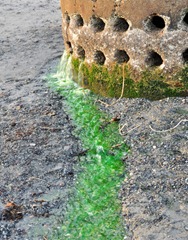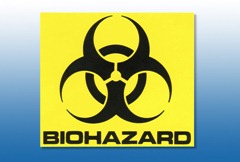Carrying Our "Body Burden" of Chemicals
 Virtually every man, woman, child and animal in the world is carrying a heavy burden of toxic chemicals in their blood, the price of living in a culture based almost entirely on extracting fuels, elements and chemicals from the earth and using them to create and operate the objects of our desire. We are only beginning to wake up to what we have wrought.
Virtually every man, woman, child and animal in the world is carrying a heavy burden of toxic chemicals in their blood, the price of living in a culture based almost entirely on extracting fuels, elements and chemicals from the earth and using them to create and operate the objects of our desire. We are only beginning to wake up to what we have wrought.
The New York Times recently had an article about a study that found loggerhead turtles, a large sea turtle that apparently commutes between Cape Canaveral and Cape May, New Jersey, had 67 identifiable industrial chemicals in their blood. All the turtles tested appeared healthy.
Also recently, researchers at Mount Sinai in New York City, who were conducting blood tests of the chemical “body burden” that New Yorkers carry, checked Bill Moyer’s blood. They found 87 chemicals were either established on just passing through his body. The quantity was typical.
Last year, the Environmental Working Group tested the umbilical cords of 10 babies from minority families and found that collectively there were some 200 chemicals in the blood the babies were getting from their mothers.
Some of those chemicals are, in effect, self-applied from cosmetics and from household, yard and garden chemicals we use in the course of our lives. They are in the varnish we apply to our floor, in  the seeds we spread on our lawns, in the lotion we apply to our hands. Others enter our systems from the untreated gases that have been released into the air from factories that are making things: plastic items, furniture, electronics…….almost everything we consume. They permeate the water we drink and wash in, chemicals that water treatment plants don’t treat.
the seeds we spread on our lawns, in the lotion we apply to our hands. Others enter our systems from the untreated gases that have been released into the air from factories that are making things: plastic items, furniture, electronics…….almost everything we consume. They permeate the water we drink and wash in, chemicals that water treatment plants don’t treat.
Even those who have decided to be cautious about the chemicals around them can find themselves blindsided. A recent study in Sweden and Norway found that “wax technicians working for World Cup ski race teams had very high levels of PFCs (perfluorochemicals) in their blood.” The problem is that the technicians – mostly healthy young men – are apparently manufacturing the chemicals themselves from a common industrial chemical, fluorotelemer alcohol, that’s in the air as they wax their team’s skis. It’s a biological process called “biotransformation.”
Most of us appear healthy, or have ailments that don’t surprise. People have always had flu, or cancer, or any of the other multitude of illnesses we are heir to. On the one hand, many of the chemicals we encounter have been clearly connected to illnesses that debilitate and kill us: cardiovascular diseases, cancer, liver damage and hormone disruption. On the other, many diseases are becoming more prevalent. The World Health Organization has stated that it expects the incidence of cancer to increase by 50 per cent world-wide by 2020. The incidence of autism was three per 10,000 before 1990; it is now 100 per 10,000, an increase by a factor of more than 30. The list of diseases that exhibit those kinds of statistical increases is very long.
 The difficulty is and continues to be the link between the chemical, the exposure, and the specific disease. The chemical industry is partly to blame. Its representatives wax hysterical the moment disclosure or regulation is mentioned, nittering about the need to keep industrial secrets and the imperative to protect the industry from being strangled by government interference. Those who use chemicals in their processes claim that they never spill or otherwise release them. How all those chemicals got into our blood and into the blood of animals that exist far from any sources of pollution is not a question to which they will answer.
The difficulty is and continues to be the link between the chemical, the exposure, and the specific disease. The chemical industry is partly to blame. Its representatives wax hysterical the moment disclosure or regulation is mentioned, nittering about the need to keep industrial secrets and the imperative to protect the industry from being strangled by government interference. Those who use chemicals in their processes claim that they never spill or otherwise release them. How all those chemicals got into our blood and into the blood of animals that exist far from any sources of pollution is not a question to which they will answer.
But the guilt of the chemical producers and users is only part of the problem and part of the answer. We, as a society are aquiescent to the chemical abuse of the earth. It is we who demand the cosmetics, the household products, the electronics, the greener grass, the shinier finish, the fireproof fabric, the longer lasting scent.
Even more profoundly, the fault lies in the technological nature of our society. Our entire technology has two fundamental sources: the fuels, metals and compounds that we extract from the earth and the plastics and other chemicals we make of them. We have only recently begun to look toward renewable resources and recyclable materials. Time is not on our side.


